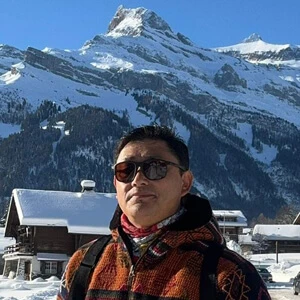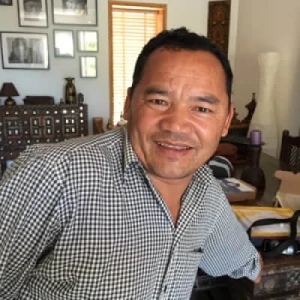Even though the Himalayas look cold and lifeless, every corner of this range has a thriving energy, stories to tell, and a rich cultural heritage tied very closely to the roots!
The Upper Mustang Tiji festival trek is one of the most famous and culturally immersive journeys in the Himalayas. Also known as the Tiji festival trek, this 20 days trip will take you to one of the biggest annual celebrations in Lo Manthang, the last forbidden kingdom in Nepal. This life-changing voyage offers both adventure and cultural heritage.
Join our Upper Mustang Tiji festival trek 2025. Beginner trekkers are also welcome to join this adventurous trek. If you think you are not fit for the trek, then book your trip early and start preparing.
Highlights
- A journey of a lifetime to the last forbidden kingdom of Nepal, Lo Manthang
- Enjoy adventurous walks via beautiful villages, canyons, high cliffs, semi-desert, and mountain passes
- The terrain is offbeat and less crowded
- Participate in the Tiji festival, the biggest annual celebration in the Upper Mustang
- Get to see different rituals, masked dances, and traditional attires
- Explore ancient monasteries, stupas, mani walls, and sky caves
- Witness arid landscapes with breathtaking mountain views of Annapurna, Dhaulagiri, and Nilgiri
- Learn about tales related to the Tiji festival that represent the victory of good over evil
What to expect during the Upper Mustang Tiji festival trek 20 days?
The Upper Mustang is a trans-Himalayan region located under the rain shadow of the Annapurna and Dhaulagiri ranges. Because of this, it does not receive rainfall in the monsoon season. Hence, the landscape is semi-desert and arid. With the joy of the festival, there will also be the thrill of trekking in the remote region.
Trekking in the Upper Mustang is considered a privilege, and attending the Tiji festival is nothing less than a once-in-a-lifetime opportunity. Before arriving at Lo Manthang, you will trek for several days via villages like Kagbeni, Samar, Ghiling, and Dhakmar. On the way, you will traverse narrow high cliffs, mountain passes under 4,500 meters, steep tracks, and landslide-prone areas.
The trail offers breathtaking landscapes and mountain views of Annapurna (8,091 m), Dhaulagiri (8,167 m), and Nilgiri (7,061 m). You will also see huge, unique rocks, alpine meadows, canyons, mud houses, deserts, and barely, wheat, potato, and buckwheat fields. Likewise, visit ancient monasteries and explore stupas, mani walls, and chortens.
Some notable places you will explore in Lo Manthang are Namgyal Gompa, Champa Lhakhang, Thugchen Gompa, Chyodi Gompa, and the Entrance Hall. You will also walk to the Choser Cave, known as the Sky Caves. These caves are thousands of years old and made on unstable cliffs. Most of the chambers still remain undiscovered because of their instability.
Why is the Upper Mustang a restricted area in Nepal?
Upper Mustang is located close to the Tibetan border, so it is a restricted area in Nepal. The Nepal government has restricted the area to maintain border security. Likewise, another big reason is to protect and preserve the cultural, archeological, and natural richness of this region.
Foreigners have to get an expensive permit, which costs USD 500 for the first 10 days and USD 50 per day after that to travel and explore the Upper Mustang. Simillary, tourists are not allowed to trek alone in this region. They can only travel here with a local trekking company like us.
Another thing to know is that there have to be at least two trekkers in the group. So, if you are a solo traveler, you either have to bring one more trekker, or we will pair you up with someone. Likewise, trekking without a guide is illegal.
Tiji festival
Tiji festival is the biggest annual celebration in the Upper Mustang. It is one of the significant festivals for the locals and is celebrated for three days. Tiji is a traditional Tibetan festival celebrated according to the Tibetan calendar. The festival marks the victory of good over evil. The entire Mustang region comes together to celebrate this festival.
According to the legend, the Tiji festival honors the victory of Dorje Jono, the incarnation of Lord Buddha, over a demon named Man Tam. Man Tam created havoc in the world and caused people suffering. Lord Dorje Jono defeated the demon and brought peace to the world.
During the three days of the festival, the locals perform many rituals and traditional mask dances. The first day of the Tiji festival involves a purification ceremony, and a series of rituals are performed to cleanse the community from evil spirits.
On the second day of the festival, the monks and the local community perform mask dances and other rituals. On the last day of the festival, the locals gather to destroy the demons' last remains. The demons are set out and attacked on old tiger skin with bows and arrows, old guns, and catapults.
The masked dancers represent various characters from Lord Dorje Jono's victory over Man Tam. You can see huge mandalas, colorful prayer flags, banners, butter lamps, and other decorations. Numerous traditional delicacies are offered to the god. Locals sing traditional songs and play traditional instruments.
How to prepare for the Mustang Tiji festival trek?
The Tiji festival is the core essence of this trip. However, to participate in the festival, you have to reach Lo Manthang. On foot, it takes multiple days to walk via remote villages, canyons, and mountain passes. Likewise, after the end of the festival, trekkers also have to walk back to Jomsom, which takes another few days of walking on the same terrain.
Therefore, trekkers must be able to walk 6 hours a day on varying terrain and elevations. A fit body, strength, and stamina are required. To prepare for the trek, you should exercise. Train your legs and core strength. Likewise, improve your stamina and endurance. Training in the gym, regular walks, day hikes, and cardio activities like cycling, swimming, running, etc are recommended.
Join Tiji festival 2025 with Himalayak Trekking
In 2025, the Tiji festival will be celebrated from 24 May to 26 May. Our Upper Mustang Tiji festival trek starts on this date. You will reach Lo Manthang on time to attend all three days of the festival. We, Himalayak Trekking, will arrange all the logistics and permits for the trek.
Our experienced native guide will accompany you throughout the trek, sharing fascinating stories and insights about the locals and the Tiji festival. He will help you communicate with the villagers. You can rely on him and freely ask him any question that may intrigue you during the trek.
With us, you will get the best Upper Mustang Tiji festival trek cost. If you want to make any changes to the package, feel free to let us know. You can trust us for a safe and satisfying trekking experience in Nepal.








